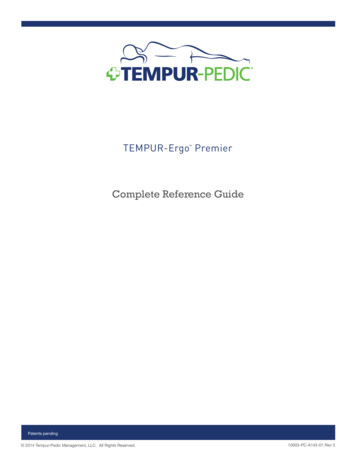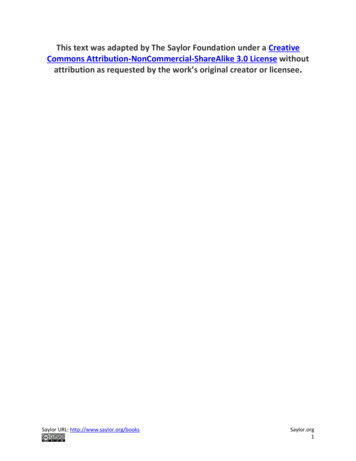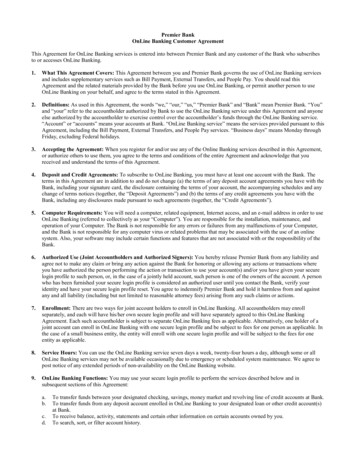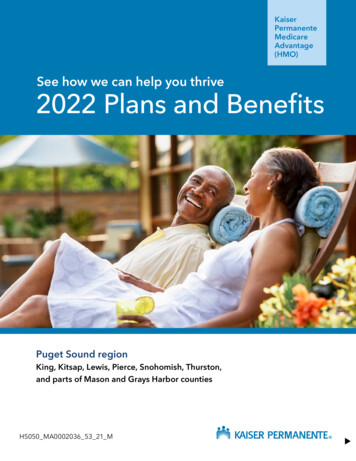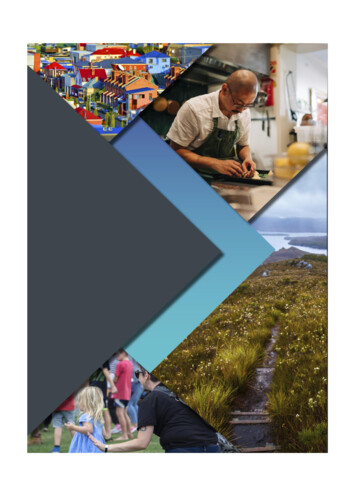
Transcription
Premier’s Economic and SocialRecovery Advisory CouncilFinal Report SnapshotMarch 2021
Council MembersDon Challen, AM (Chair)Professor Rufus BlackDale Elphinstone AOTim GardnerKym GoodesSamantha HoggLeanne McLeanPaul RansonBrett Torossi*****In preparing this Final Report, we have had the benefit of considerable data andinformation from thousands of Tasmanians from all corners of the State.Our thinking has been informed by: published and unpublished data and information available to us; our multi-faceted consultation program with Tasmanians, including awell-being survey that over 3 000 people participated in and a program of12 workshops around Tasmania examining potential COVID-19 scenarios; and information contained in submissions to us and through our on-line feedbackportal.We have made available on our website (www.pesrac.tas.gov.au) the submissionsthat we received during both phases of our work, and the outworking of ourconsultation processes. We have not sought to reproduce this information in this FinalReport.*****The Council would like to thank the team that comprises our Secretariat in supportingus in our work over our two Phases, and the Departments that have made thesepeople available to us.Adrian ChristianMark BowlesBen GoodsirKerry HudsonLuke Murphy-GregoryIlise BourkeCameron McLennanSam ThiessenSophie BuchhornNick MerseThe Council would also like to thank Prof Benjamin Brooks and Dr Steven Curnin of theUniversity of Tasmania, and Ms Alicia Leis of Wise, Lord and Ferguson for facilitating ourcross-sector workshops and regional roundtables.AuthorPremier’s Economic and Social Recovery Advisory CouncilGPO Box 147Hobart TAS 7001PublisherDepartment of Treasury and FinanceDateMarch 2021 Crown in Right of the State of Tasmania March 20212
1. How we got hereOn 31 December 2019, the Wuhan Municipal Health Commission reported a clusterof cases of pneumonia in Wuhan, Hubei Province, marking the arrival of a novelcoronavirus (COVID-19).This set the world on a course that it was not prepared for. Like other places aroundthe globe, COVID-19 has left an indelible mark on Tasmania and its people, and thelonger-term ramifications are still to be worked through.Tragically, 13 Tasmanians lost their lives to the virus in 2020. A great many more lostlivelihoods due to the measures that had to be introduced to manage the virus’spread. Businesses have been closed and investment plans shelved. While jobs havereturned since the low point in May 2020, there are 3000 more Tasmaniansunemployed than there were in March 2020.The social consequences have been widespread, and continue - a year on, familiesremain separated by international borders, schooling has been disrupted, marriageplans set aside. Some parents had to deal with losing their job or having much lessincome. At the same time, they were helping their children with home schooling.Social impacts have included drug and alcohol misuse, family, and communityviolence, increased situational distress, and widened socio-economic disadvantagethrough job losses and decreased community connection.Some positives have emerged from the COVID-19 experience. Many of us quicklyadapted to new ways of working and doing business. The tyranny of distance facedby some businesses has been mitigated by online business models. In many ways,COVID-19 has shone a light on the benefits of being in Tasmania and reminded us thatit’s easy to take some things for granted.The Tasmanian Government acted swiftly to implement measures to suppress COVID19, and deal with the immediate health impacts. Because of Tasmanians’ willingnessto act responsibly, those suppression measures have proven to be effective inmanaging the direct health consequences of the virus.However, suppression measures here and COVID-19 impacts elsewhere haveaffected all Tasmanians.Recognising this, on 30 April 2020, the Premier set up his Economic and SocialRecovery Advisory Council (us) to provide him with advice on how best to supportTasmania’s short, medium, and longer-term recovery from COVID-19.In two months, we provided the Premier with an Interim Report, containing a packageof 64 recommendations aimed at the short and medium-term recovery. TheGovernment accepted all of them and is working through their implementation.The Premier set us a second task. That was to leave the ‘here and now’ impacts andlook over the horizon to the medium and longer-term. We have set that timeframeas 2 to 5 years.Looking into the future to think about COVID-19 is a tricky task. There is a long way togo before the full consequences of COVID-19 will be clear.3
The future of the virus and the uptake and efficacy of vaccines will play a big role indetermining the longer-term impacts of COVID-19.A key uncertainty is the impact of the progressive removal of economic supportsprovided by the Australian Government, particularly income support measuresceasing at the end of March 2021.We know that many Tasmanians are very concerned about these changes. For some,the additional income support has been life-changing, and returning to how thingswere pre-COVID-19 will create new hardship.These uncertainties, and the future-oriented aspect of our work, meant that we hadto take a different approach to that of our Interim Report. Rather than looking to datato guide our thinking, we have widely engaged with everyday Tasmanians.What we have been looking for are practical measures that will assist Tasmanians tobuild their own future - not one that we have picked for them.We have taken a whole-of-state approach to identify the priority areas, looking forthe common themes across people, places, and sectors. We have focussed ourattention on areas where there are gaps, rather than duplicating work that is alreadyunderway. Along the way, we have collected a wealth of rich information. We havemade it all available on our website (www.pesrac.tas.gov.au) for others to work within looking at recovery in their own spheres.Our recommendations have been built on what we have heard from Tasmaniansthrough one of the largest listening exercises undertaken in recent years. Four strongthemes emerged: creating new economic opportunities and linking people with them; making sure the health system remains ready to deal with COVID-19, andaddressing mental health, food, and housing needs; building community connection and engagement; and increasing the focus on the environment and sustainability.4
2. Creating opportunities and linking people with themOne of the strongest messages we received was that building economic opportunityis a primary goal, because it will provide jobs, and getting people back into work iscritical in heading off a range of negative social outcomes.There is a great deal of hope and excitement among Tasmanians about economicopportunities in ‘new economy’ areas - the environment, renewable energy, and thecircular economy - as well as areas that Tasmania has traditionally done well in, suchas tourism, agriculture, and mining.Major investments are important for driving opportunity, improving confidence andexpanding opportunities for smaller business. We also heard about the importance ofsmaller scale niche opportunities that will be easier to progress than larger-scaledevelopments.While growing the economic pie has been a major theme, there has been anaccompanying message that this needs to proceed thoughtfully - growing from withinis important, rather than simply trying to compete with other places in attracting newbusinesses that don’t understand Tasmania and its culture. The other clear theme isthat major investments need to align with Tasmania’s brand strengths. A keyconsideration put forward was the importance of not trading away Tasmania’senvironmental values in pursuit of shorter-term economic opportunity. We agree.We think more can be done to help projects get from the drawing board to shovelready. Investing in better and more transparent facilitation processes and a sharperfocus on the timely progress of permitting and authorising activities are ways ofmaking it easier for investment to be undertaken without cutting any importantchecks and balances. It’s not about lowering standards to secure new opportunities,but getting timely decisions using transparent processes, and building a culture ofengagement and collaboration with developers.Major InvestmentsProtecting sustainability, community values and Tasmanians’ well-being mustcontinue to be at the forefront of regulatory activity.Approval and permitting processes should be resourced to deliver timelyoutcomes.Enhancements to project facilitation resourcing and processes are needed.Agency heads should drive and be held accountable for a public sector-wideculture that proactively engages with major investment proponents.But building economic activity is only part of the story. There’s little point forTasmanians in a growing economy if it doesn’t deliver jobs and income for them. Thismeans we need people to have the right skills for new opportunities, and we need toget people into the new roles.5
We need our young people to be better prepared for work while they are at schooland to have strong pathways between further education, training and work.Skills, Schools and YouthThe Year 9 to 12 Project Vocational Learning elements should be finalised andimplemented in strong ongoing consultation with industry. Their implementationshould be funded.In relation to skills, we received a strong, consistent message that TasTAFE is critical indelivering the training needed to fill existing and new employment opportunities. Weequally heard that under its current framework, TasTAFE can’t keep up with whatTasmanians need, despite its efforts to date.We agree on both fronts.Tasmania’s young people entering the workforce, and those already engagedlooking to upskill or re-train, need TasTAFE to deliver the skills required by Tasmanianbusinesses. Otherwise, they face the prospect of investing their time and money intotraining that business doesn’t value, and the pathway to new job opportunitiesremains blocked.TasTAFE needs to be a lot more like its clients - flexible and adaptable to meetingemerging needs. It simply can’t do that now. That’s why we are recommendingre-establishing TasTAFE as a government business with the same operational flexibilityas other key economic infrastructure providers, operating at arms-length from theGovernment outside the Tasmanian State Service.Skills and TasTAFETasTAFE should be re-established as a government business under the controland accountability of its Board, with authority and power to employ its workforceunder the Fair Work Act 2009.Industry bodies (associations and employer representatives) should enter intoindustry compacts with the State Government that includes ‘step-up’commitments to support a re-established TasTAFE and better promote theavailability, attractiveness and benefits of jobs in their industriesIn relation to matching Tasmanians who want to work with appropriate jobs, we heardthat the Australian Government’s jobactive system just isn’t working. A top priority forrecovery is getting people that have lost work, or are underemployed, into work.Attention can then shift to young job seekers, to help address the structural problemof youth unemployment.This is going to require the State Government to step in with both feet, building on thesuccess of recent pilot schemes in Tasmania that take a much more person-centredapproach to matching people with jobs. We are calling for the establishment of Jobs6
Tasmania Local Networks across the State. The Local Networks would provide thefinancial and service support that local communities need to be able to tackle thebarriers that exist at the local level.Job MatchingA State-wide set of Jobs Tasmania Local Networks should be established toundertake place-based job matching, coaching and referral services.3. Health, Mental Health and HousingJobs and income emerged as highly important themes, but Tasmanians told us thathealth is their number one priority, for their general well-being and for recovery.The main physical health issue raised in relation to COVID-19 recovery is making surethe health system is properly resourced to deal with outbreaks. The Government hasaccepted all the recommendations of the review into the outbreak in North WestTasmania, which aim to prepare the system for further outbreaks. We are calling forroutine updates on actions taken.We are all keen for life to return to ‘normal’, albeit in a COVID-safe way. People wantto be able to return to visiting family interstate, and to be able to resume business andleisure activities that involve us moving around the country.A key ingredient needed to help people and businesses plan for a COVID-19 future isbeing able to understand the approach that will fbe taken by governments tomanage outbreaks. We think more needs to be done by the Government to explainthe basis for imposing and removing restrictions.Communication and ConfidenceThe State Government should better communicate with Tasmanians about itsCOVID-19 management strategy (including how any future outbreaks will behandled); and provide regular updates on the initiatives to prepare the State’shealth system response to future COVID-19 outbreaks.We heard a lot more about mental health than physical health in our consultation.Situational distress was exacerbated by COVID-19, and this is expected to increase inthe future. The mental health system is complex, and for people that are experiencingdistress for the first time, it is difficult to find the most appropriate service and help. Weare calling for more effort in this area during recovery - telephone-based services,online resources, and face-to-face connection.7
Mental HealthThe State Government should: finalise, fund, and implement its Mental HealthPlan (Rethink 2020) as a matter of priority.The State Government should fund telephone and online services to assistpeople navigate the mental health system so that they can access the rightservice quickly. It should implement a mental health Youth Peer Worker model.Access to nutritious food and suitable housing are key supports for being healthy.Tasmanians are worried about both. They are concerned that this will become moreproblematic if economic and social recovery is slow.Food SecurityThe State Government should ensure that the Food Security Strategy currentlybeing prepared expands on recent trials of school lunch provision, is linked tolocal agricultural and hospitality businesses, and is ‘scaleable’ and placebased in design, so that any potential increase in demand for emergency foodrelief can be managed.COVID-19 has reinforced the importance of appropriate housing for Tasmanians. ‘Staysafe: stay home’ is only meaningful for people who have a safe and secure residence.The successful management of COVID-19 depends on everyone having a safe homewhere they can self-isolate if needed. For some Tasmanians this exacerbated theirconcerns about the stability of their living situation.Tasmania’s housing markets were becoming increasingly dysfunctional prior toCOVID-19 and the pandemic hasn’t fundamentally changed that other than toexacerbate it. The current national and state-based housing stimulus measures, whilegood for boosting short-term economic activity, are not necessarily good for buildingcosts and home affordability (we flagged this in our Interim Report).Housing policy in Tasmania tends to focus on the crisis point. This should always be afocus for Government, but a broader approach is required to address the structuralissues that will make Tasmania’s housing markets function better.8
HousingThe State Government should develop a comprehensive Tasmanian HousingStrategy and drive practical actions to deliver more sustainable housing marketoutcomes for all Tasmanians.4. Community - connection and engagementCOVID-19 has reminded us of the importance of community connectedness andengagement. This was another strong theme in our consultation. We heard muchabout need for face-to-face connection in recovery as well as the barriers to peopleconnecting online.COVID-19 has delivered a step-change in the use of online approaches for manyaspects of our everyday lives - education, working from home, connecting with lovedones, shopping, accessing health services and even accessing basic governmentservices. There is no going back in the evolution of online approaches, and COVIDhas kicked up the pace.Many of us have benefited from these changes but Tasmanians that lack access toequipment or infrastructure, or do not have the necessary digital literacy, have fallenfurther behind. Tasmania’s digital divide was well known prior to COVID-19, with thegap between the ‘haves’ and the ‘have nots’ only being widened by it.The digital divide needs to be genuinely tackled by the State Government.Digital Infrastructure and InclusionThe State Government should take an active role in strengthening Tasmania’sdigital infrastructure, particularly in our regions.The State Government should set clear whole-of-government Key PerformanceIndicators (KPIs) for closing the digital divide (with a focus on affordability,access, and ability) and provide funding to address the KPIs.Another strong message was the desire of communities to be involved in designingand delivering recovery approaches. The approach taken by the Government in theimmediate management of COVID-19 to genuinely engage at the local level andrespond in a timely way has cemented this expectation.In developing recovery mechanisms, the Government and its agencies should startby actively looking for opportunities to apply place-based approaches. This starts byinvolving target communities (people, sectors, or places) in co-designing approaches9
to recovery, and then considering how they can operate flexibly to address differinglocal needs.In return, the community needs to ‘turn up’ and take part in the process (as theycertainly demonstrated in our processes), and there needs to be a pipeline of willingand appropriately skilled community leaders who are involved.We arerecommending that the Government establish an ongoing scholarship funding poolto financially support community leadership training to develop future leaders.We heard about the importance of community engagement, and the opportunitiesthat community-based events present, both in a social and economic terms. Weheard about the difficulties that community organisations can have in getting theseinitiatives off the ground because of the risk of disruption from COVID-19 restrictions.There is a role for Government to underwrite COVID cancellation risk to support thereturn of community-based events.Community and Place-Based RecoveryThe State Government and its agencies should develop recovery approachesby actively looking for place-based opportunities.The State Government should financially support leadership training forindividuals that have demonstrated involvement in their local community.The State Government should support community-based events by sharingCOVID-19 risks.5. Sustainability and the environmentThe last major theme emerging from our consultation is the importance thatTasmanians place on the environment and the view that it is imperative that the Statebuilds its sustainability credentials. Tasmanians told us that the environment is essentialfor their health, well-being and for their leisure. They also recognise that it’s central tothe State’s economic prosperity.Tasmanians told us that we can’t rely on the sustainability ‘head start’ we have relativeto other places thanks to our natural environment and history. Decisive action isneeded across a range of fronts to build Tasmania’s sustainability credentials. Theworld is paying much closer attention to environmental sustainability credentialsaligned with the United Nations Sustainable Development Goals, and other placesare stepping up efforts to become more sustainable. If we are to keep a competitiveedge, we too need to move our goalposts.The collective message we’ve heard is that Tasmanians are looking for a publicarticulation of a vision to address the challenges of climate change, living sustainably,creating a stronger Tasmania for future generations, and showcasing our values to theworld.10
The task now is for the State Government to articulate that vision and to develop abroad-based strategy that brings that vision to reality for, and on behalf of,Tasmanians.The vision and strategy need to set the short, medium, and long-term agenda forsustainable economic, social, and environmental growth, with ambitious goals andmeasurable targets, and concrete actions to deliver the targets.But the task is much wider than this. It is important that Tasmanians adopt a culture ofcontinuous improvement and innovation in relation to their environmental footprint,in their own lives and in their businesses. This will require some candid self-reflectionand ambitious shifts in thinking around the environmental impacts of our economicand social activities, and how we can improve individually and collectively.Environment and SustainabilityThe State Government should develop a sustainability vision and strategy forTasmania, with ambitious goals and concrete targets and actions.The strategy should have a strong focus on environmental considerations. Itshould include wider aspects of sustainability including social factors and ensuredecisions account for the interests of future generations.6. Our public sector institutionsAs we said in our Interim Report, the task of COVID-19 recovery is one for allTasmanians. Nonetheless, we recognise that our State-based public sector institutions- the State Government, the government businesses sector and local government will shoulder much of the load. Each needs to have the capacity to supportTasmanians in the recovery effort.The ability of our public sector to rapidly respond to emerging needs is vitallyimportant, given the uncertainty over how COVID-19 might manifest in the future.Regardless, Tasmanians are calling for, and deserve, a well-functioning and effectivepublic sector that is focussed on them.This is why the work currently underway through the Watt Review is important. Wesupport his Interim Report recommendations, and his final report, due in May 2021, willbe central in shaping the future of the State Service to ensure that it is fit-for-the-futureand better able to meet the needs of Tasmanians.The community sector is the State Government’s service delivery partner, particularlyin fields that are central to the COVID-19 response. This partnership has been key tothe success of the emergency response to-date and supporting the ongoingwellbeing of Tasmanians from all walks of life. Over the longer term it is important thatcommunity organisations have a funding and contracting environment that supportstheir ability to best respond to evolving community needs.11
Community Service FundingThe State Government should review funding models for community serviceorganisations to enable flexible service delivery focussed on place-baseddemand, to ensure they remain viable in the face of increasing costs andchanging demands.COVID-19 is not the only low probability high consequence event to befall the Statein recent times, coming relatively recently after the 2016 energy crisis. Both eventswere not ‘black swans’. Although of low probability, they were predictable. In bothcases, they developed into a crisis because the State was not prepared.Fortunately for Tasmanians, the Government, its agencies and recovery partners wereable to quickly devise and implement strategies to deal with emerging issues.The Government needs to build on the lessons of COVID-19, develop a structuredprocess for identifying high consequence risks to which the community is exposed,and develop and implement mitigating strategies for each of them. Some of this workis already reasonably established (eg. natural disasters), but for other risks there is along way to go.Planning and PreparationThe State Government should develop a structured process for identifying highconsequence risks to which the community is exposed and develop andimplement mitigating strategies for these risks (including identifying and testingsurge capacity arrangements.)The role of government businesses in recovery is important, as they are core providersof the State’s infrastructure. Tasmanians, as the ultimate owners of these business,need them to be focussed on whole-of-State strategic outcomes, because that iswhat will make a difference in their lives. This is going to require strong leadership fromthe State Government to transparently establish these priorities and hold Boardsaccountable for delivering against them. We have suggested that changes to thegovernance model could provide a clearer path for this to happen.Government BusinessesGovernment businesses should focus on whole-of-state priorities during recovery.The government business governance framework should be revisited to enablethe government of the day to set binding whole-of-state strategic priorities.12
In relation to local government, we have heard much about place-basedapproaches and the important role that local government will play as a recoverypartner. For it to do this, the sector needs to be resilient and sustainable. Currentlysome local governments are not. The longer-term outlook for the whole sector istroubling and the case for reform is well understood.The current approach to addressing the sustainability of the local government sectoris piecemeal and based on voluntary incremental change. This has proven to beineffective. Tasmania faces a stand-off on local government reform, with no politicalparty being prepared to ‘risk’ taking on reform. That stand-off must end.That is why we are calling on the Parliament to sponsor a process to drive structuralreform from a ‘clean sheet’ perspective. Parliament should set the terms of referencefor the process, which would be undertaken by an expert panel, and run for about 18months. In starting the process, Parliament should signal the expectation it will deliveran outcome that sees fewer local government areas with a wholesalereconsideration of local government boundaries; and centralisation of someoperating activities to achieve genuine scale. Parliament should make it clear thatthe outcome will be implemented without material modification.Local Government ReformThe Tasmanian Parliament should sponsor a process to drive structural reform toTasmania’s local government sector.7. Stepping backSome 3500 Tasmanians have been involved in our consultation processes.We have listened to what Tasmanians consider important for their own well-being.That’s why our recommendations are based on the well-being pillars of jobs, income,health, housing, community, and the environment.We sat with people from business and community sectors in workshops and soughttheir insights into the ‘on the ground’ consequences, constraints and opportunitiesthat they could face if COVID-19 takes a relatively ‘good’ path, and what it mightmean if things don’t turn out so well. We asked them to identify the best opportunitiesthat emerged from those workshops.We have taken that work and come alongside people from regional Tasmania to testwhat resonates from a regional perspective, because we know there are differencesfor regional Tasmania relative to our urban and city areas.We also considered over 150 traditional and short-form submissions made to us byindividuals, peak groups, and businesses.Our recommendations reflect the priorities that emerged from this comprehensivelistening exercise.13
Tasmanians are calling for better approaches that give everyone a better chance ofsuccess in areas like preparing for work, getting a job, and navigating the digital world.These are at the heart of our recommendations, which aim to promote recovery,resilience, and opportunity.Even if Tasmania remains fortunate enough to avoid the worst of COVID 19, there willbe other shocks and challenges facing the State in the future - natural disasters,geopolitical tensions and uncertainty in global trading conditions for instance. Ourrecommendations will fortify Tasmania’s capacity to withstand future challenges,COVID-related or otherwise.Just as it took all of us working together to ‘flatten the curve’, it will take a whole-ofTasmania approach to recover from COVID-19’s impacts.The Government must lead but cannot shoulder the whole responsibility for recovery.Every Tasmanian has a part to play in the recovery from the pandemic and in buildinga better Tasmania. Our consultation has reinforced that Tasmanians have a willingnessfor this task. Our recommendations are not just for the State Government, they are forall Tasmanian organisations and our community.Cover photo credit Roaring 40’s Ocean Kayaking, Tourism Australia & Graham Freeman Taste of theHuon, Chris Phelps Fico, Osborne Images14
University of Tasmania, and Ms Alicia Leis of Wise, Lord and Ferguson for facilitating our . Recognising this, on 30 April 2020, the Premier set up his Economic and Social Recovery Advisory Council (us) to provide him with advice on how best to support . consideration put forward was the importance of not trading away Tasmania's .

![Myob Accounting Software Free Crack Windows [BEST]](/img/57/myob-accounting-software-free-download-crack-windows-best.jpg)
